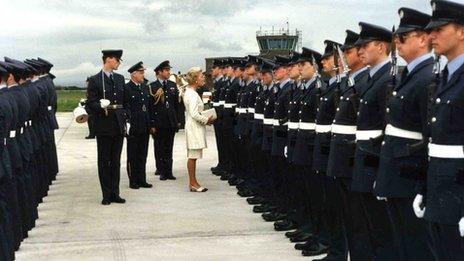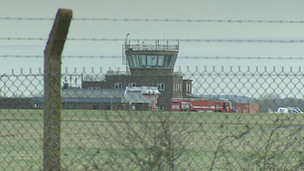St Athan RAF base celebrates 75th anniversary
- Published

St Athan has welcomed many royal visitors over its 75 years, including the Duchess of Kent
An RAF base once thought to have become obsolete within two years of opening is celebrating its 75th birthday.
The anniversary at St Athan will be marked with a day of special events including a service in the base's chapel and a veterans parade.
There will also be a fly-by from many of the vintage aircraft stationed there over the years and dinner in the mess.
In recent years the Vale of Glamorgan airbase has reinvented itself as a state-of-the-art training facility.
It is also a rehabilitation centre for injured serviceman and is, according to its station commander, testament to the tenacity and versatility of all who've served there throughout its history.
The base had previously missed out on a multi-billion pound contract for an RAF academy, while at the same time losing its last remaining military aircraft maintenance contracts.
"We're no strangers to having to compete for our very existence here at St Athan", said Wing Cmdr Paul Regan.
"But the fact that we're still here, in such tough economic times for the MoD, shows that the work we do is vital across the armed forces."
But the truth is, uncertainty over the future is nothing new to the staff of the base - its entire history has been a battle for survival.
'Safe haven'
Originally conceived in 1938 as a maintenance base, the site was chosen because it was thought that south Wales would lie beyond the range of Luftwaffe bombers.
But within two years of 32 Squadron, Maintenance Unit (32MU) and 4 Squadron, School of Technical Training (4TT) moving in, the concept of a safe haven had been rendered obsolete.
On 20 June 1940, a German attack on RAF St Athan launched from captured French airfields brought the war to Wales for the very first time.

The Duke of Edinburgh visiting St Athan
Brian Acott, St Athan's archivist and military historian, who served 37 years with 4TT from 1955, said the base faced an uncertain future.
"Once the notion had been shattered that the RAF could have a site beyond the reach of the Luftwaffe, where they could maintain and repair aircraft at their leisure, the War Office began to question whether St Athan offered anything they didn't already have at other bases," he said.
"The other problem was that at the height of the war, and particularly during the Battle of Britain, we were going through planes at such a rate, that the whole idea of even bothering to repair them at all seemed like King Canute trying to hold back the waves.
"So we had to re-invent ourselves for the first time, becoming experts in the reclamation of badly-needed spares from irreparably damaged aircraft, thus finding a niche to carry us through the rest of the war."
According to Wing Cmdr Regan, it's a tradition which persists to this day.
"The recruits who come to St Athan today arrive with 10 weeks basic training and leave eighteen months later with such a range of engineering skills that we often have a job to hold onto them within the forces," he added.
"We may not do the glamorous work here, but our graduates are the young men and women with the ability to repair equipment under fire, or manufacture a bespoke part for an aircraft in the middle of Afghanistan when it could take weeks to fly one in from the UK."
Fighter jets
St Athan ran into controversy in the 1950s when the base was given the task of maintaining Vulcan Bombers which carried Britain's nuclear warheads.
But when the nuclear deterrent shifted from bombers to submarines, 32MU's future in south Wales was again thrown into doubt.

The airbase has become a state-of-the-art training facility and rehabilitation centre
During the late 1960s and early 1970s St Athan was earmarked for closure, before another MoD U-turn brought them the maintenance contract for the RAF's fleet of VC10 air tankers, followed a few years later by the newly-launched Tornado fighter jets.
It was to mark a high point in the base's public relations, once again gaining popular affection by exploiting the variety of new planes present to hold annual Battle of Britain air shows throughout the 1980s and 1990s.
But the new century brought a string of raised and dashed hopes, as fast jet maintenance was taken elsewhere and the base was then overlooked for a £12bn military academy.
Wing Cmdr Regan added: "Many of the veterans we have attending the celebrations have told me that in 1938 - and on pretty much every year since - people have confidently predicted that St Athan wouldn't see the year out.
"But with the excellent work of 4TT training ground crew, and 14 Signal Regiment based here through 2018 and beyond, I'm confident that on its 75th birthday St Athan remains as relevant as ever."
- Published5 March 2013
- Published18 July 2011
- Published19 October 2010